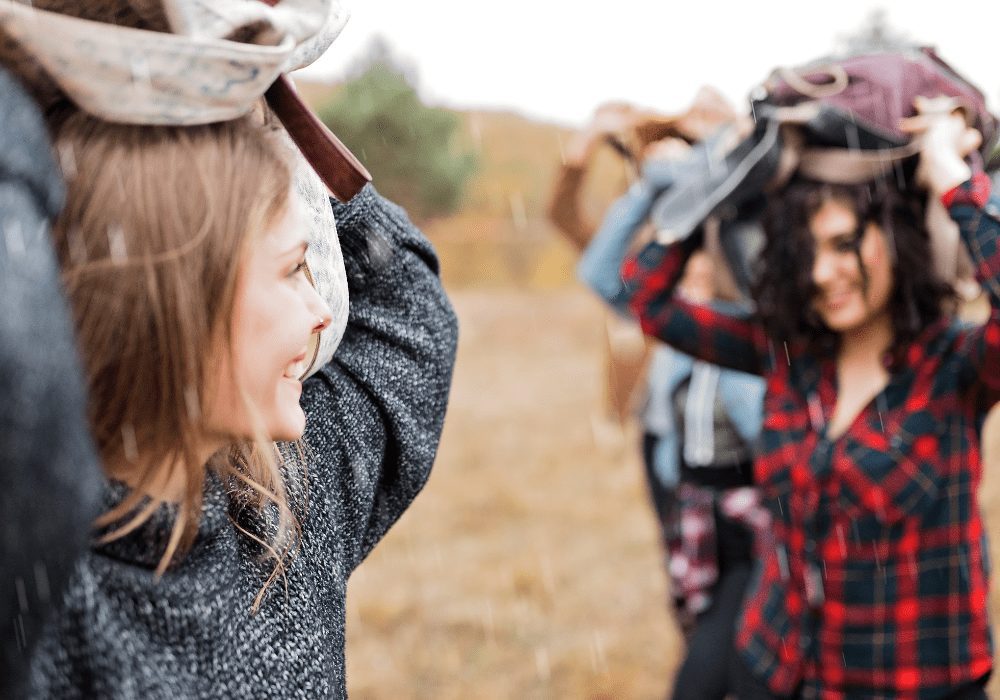
20 Savvy Tips For Hiking In The Rain
Estimated reading time: 19 minutes
Over the years I’ve identified several pro level tips for hiking in the rain.
For many people, nothing puts a damper on an excellent hiking trip quite like a rainy forecast.
However, a little rain shouldn’t stop you from getting outside. In fact, hiking in the rain can be fun, and healthy especially if you go into it prepared.
Remember, staying dry is easier than drying out after you’re wet. Don’t wait to throw on your rain shell, or to take cover in a downpour.
And definitely don’t hit the trail without considering the following tips from a lifelong Pacific Northwest Adventurer.
Learn how to stay dry & choose the right trail, clothing & gear with these 20 simple tips for hiking in the rain.
Before we jump in to our tips, let’s take a quick look at the benefits of hiking in the rain.
Table of Contents
20 Pro Tips For How to Hike or Backpack in the Rain

Backpacking and hiking are essentially the same thing.
The difference being that backpacking trips are longer, and typically spread over multiple days.
From wet socks to slippery trails, hiking in the rain is certainly not fun if you’re not properly prepared.
However, if you are prepared, hiking in wet weather can be as enjoyable as hiking in dry weather.
Before you head out, be sure to checkout and bookmark our 9 Critical Day Hike Essentials.
Benefits Of Hiking In The Rain

Hiking in general is a healthy activity, but there are enhanced benefits that come with hiking in the rain.
Believe it or not, hiking in the rain can be quite a healthy experience.
For instance:
- The smell of rain, Petrichor, is proven to have a soothing effect on people
- You burn more calories during outdoor activities when it’s raining
- Your heightened senses will increase blood flow and cognition
- Humidity makes your skin healthy, clean, and fresh
- The air is less contaminated during the rain
- Wildlife will stand out more than usual
- You’ll notice more greenery
While it might not be your first choice, rainy day hikes can offer solitude and a special ambiance, especially if you’re dressed to stay dry and warm.
Below are tips for planning a rainy-day hike and staying safe while you’re on the trail.
Prepare To Have A Fun Hike During Inclement Stormy Weather
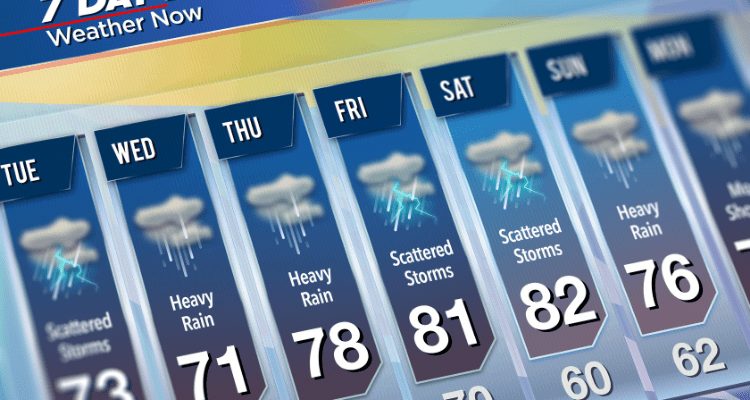
Even the best formulated adventure plans can go awry, so be prepared with how to hike in rainy weather with these 20 pro tips.
How many times have you heard, “mindset is everything?”
You’re going to hear it again here as it can make or break an adventure.
Any time you go hiking, be prepared for rain, cold, sleet, hail, snow, fog and basically anything else mother nature can throw at you.
Hiking (and camping for that matter) in the rain can be quite fun and a great opportunity to experience an area from a new perspective. There is also more chance to have the trail to yourself.
Rule #1, always check the weather before heading out on a hike or any outdoor adventure.
When To Cancel Or Postpone Your Hiking Trip?
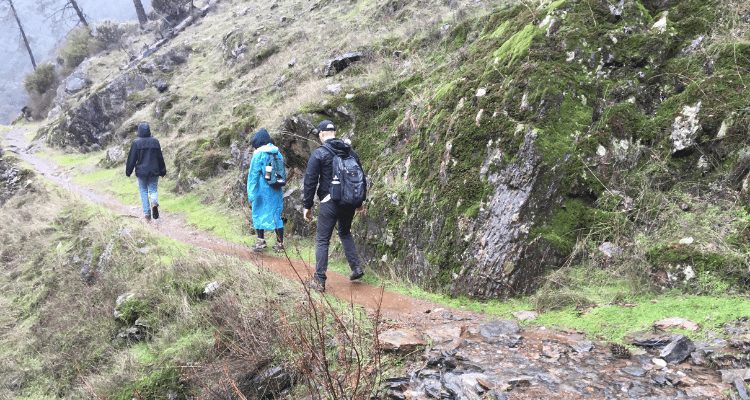
Might not look like it, but we were sliding all over the trail during this downpour in Northern California
This is personal preference, but I usually don’t cancel hikes.
If it’s raining, great, the trails will be all to myself. If it’s windy, snowing etc… I’m still going as long as I am convinced my truck can still make it out afterward.
I’ve even hiked through/very near to a California wildfire (not recommended, but you get the idea). The point is, assess your own skill level, danger, and spirit when determining whether or not to postpone a hike.
All that said, I still don’t hike in thunderstorms.
The Best Trails To Hike In A Rain Storm

Where you hike depends on your fitness, experience and whether you have kids with you.
The waterfall you heard about? A little rain will only make it more epic. Crossing rivers and streams? Probably better saved for a drier day.
Even if the rain stops, wet vegetation and soaked trees can still affect you. Wider and exposed trails are best post-rainstorm.
Here’s a short story from a recent adventure:
These days my team and I are trying to hit all the country’s high points (75+ so far!).
We’ve had beautiful days for Mt. Whitney, Mt. Shasta, Mt Williamson, Mt. Elbert and Rainier.
Mount Massive in Colorado was another story. We camped at Windsor Lake and fell asleep under spectacular stars.
Our forecast was showing good weather until late afternoon, early evening. We got moving just before 5am to beat the potential afternoon thunderstorms.
As we climbed, it was obvious the weather was turning. Under winds gusting up to 50 mph and heavy rain, we hit the 14,000-foot summit.
Guess what we saw?
Clouds.
Still worth every step, and a proud notch in our adventure belts.
Be Aware Of Trees, Rocks and Lightning During Rainy Weather Adventures

It is vital that you treat storms, and Mother Nature with respect.
When the ground is saturated, and more so when the wind is blowing, it’s easier for trees and rocks to fall.
Also, Lightning is no joke, and being caught outdoors in a severe storm can definitely be dangerous.
Here’s how to properly handle lightning and thunderstorms when hiking:
- Do not be near bodies of water
- Take shelter if you are out in the open
- It’s likely safer outside your tent than inside
- Get off peaks as quickly and safely as possible
- Avoid shallow caves, deeper caves are likely a better option
- Know how to read the clouds for forming thunderstorms (thunder clouds often resemble anvils)
- Avoid tall lone objects (trees, boulders, rock formations, powerpoles, signs), instead look for groups of trees
- Abandon anything metal (temporarily ditching your poles and backpacking gear until the thunderstorm passes)
- If you feel tingling, hair standing up or hear a buzz, move immediately! Run as fast and far away from that location as you can
There are entire books written about outdoor adventure safety, but these are a great starting point.
Additional Safety Tips for Hiking In The Rain
Heavy rain, high winds, and low temperatures, represent some of the most challenging weather a hiker can face.
If the thermometer drops below 0°C / 32°F hypothermia and frostbite are a real possibility.
With situations like this, layers are critical, and you want to keep moving if you can.
Why Does Rain Gear Wet Out?

Follow the cardinal rule and keep the following items dry for the end of the day:
- At least one pair of socks
- Sleeping bag (if you’re backpacking)
- Any sensitive gear (i.e., paper maps, electronics, fire-starter)
In fact, keep everything inside your pack as dry as possible!
Our Teton sleeping bags made with microfiber PolarLite insulation which will protect us when wet.
Unless you have a fully waterproof backpack, or waterproof components of a backpack, there are other strategies.
A pack cover is the most obvious, and most packs actually come with this nowadays. You could also line your backpack with a plastic garbage bag.
Using dry bags and ziplocs inside your pack will help ensure the safety of individual smaller items.
Breakdown Of What To Wear Hiking In The Rain
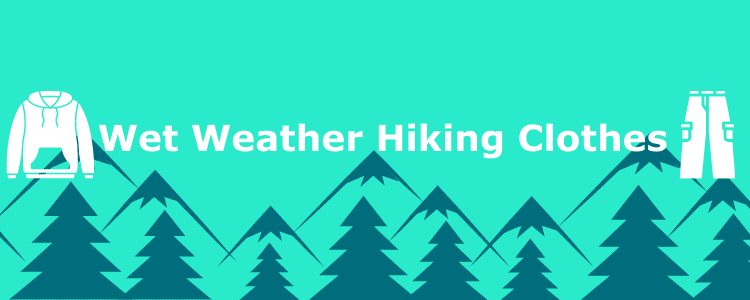
With the correct equipment, it’s possible to stay dry enough to enjoy hiking in the rain without bathing in mud.
Dress in layers and layer with the proper materials.
When you’re on the move, it’s easy to overheat, so make sure to remove layers for long walks and uphill climbs. The opposite is true for breaks – when you stop moving things will quickly get chilly, so keep an extra warm layer to throw on under a raincoat.
What does a clothing system for rainy hiking look like?
Summer:
- Running shorts or hiking pants
- Lightweight synthetic t-shirt
- Ultralight rain jacket
- Rain pants (unless the weather is really warm)
- Baseball/trucker/rice hat to shade your eyes and protect your face from sweat
- Authentic Shemagh
Fall, winter, and spring:
- Hiking pants
- Long-sleeve baselayer/quarter-zip top
- Rain jacket
- Rain pants
- Baseball/trucker hat
- Depending on how wet/cold the forecast is, we also often bring a warm hat, a fleece pullover, liner gloves, and/or rain mitts
Camp clothing essentials for backpacking:
- We always save a dry down jacket
- Pair of base-layer pants
- Warm hat
- Pair of cozy socks for use in camp and for sleeping
- Authentic Shemagh
While hiking, it’s important to wear clothing that dries quickly. Synthetic fabrics, like polyester and nylon, wick moisture away from the skin and are generally durable and affordable.
Wool maintains warmth even when wet and is naturally antimicrobial for minimal odor buildup. Cotton should be avoided. It stays wet and holds moisture against the skin, which can cause problems like hypothermia, chafing, and blisters.
We are regularly testing and adding more hiking clothing to our outdoor adventure shop.
Hiking Rain Jackets
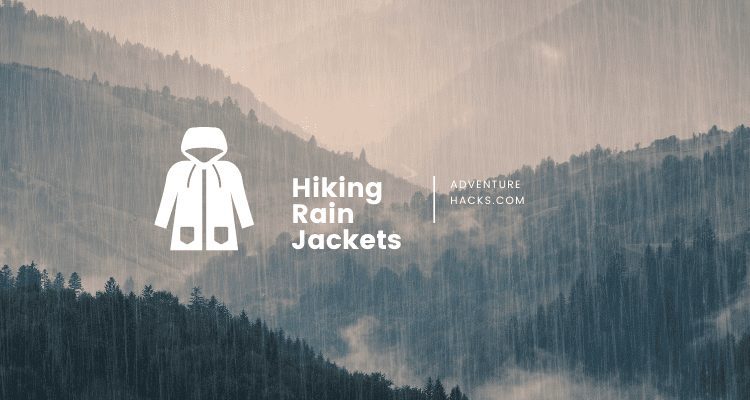
Invest in a quality waterproof and windproof jacket.
One of the best ways to stay warm when hiking in bad weather is to eliminate wind-chill. A good top-layer jacket will help you do this, while its waterproof qualities keep your layers dry underneath.
Ventilation zips in the sides of these jackets allow breathability so your sweat doesn’t soak you from the inside.
Unzip these in warm rain, and zip them in cold rain.
In warmer rain, I will unzip and put the jacket on backwards so the opening is on my back. This allows my body to cool, while my front stays dry.
My Marmot KT Component jacket is probably my favorite wet weather jacket to hike in. Keeps me dry, warm, and comfortable, while still allowing my body to breathe during tough hikes.
It’s a 3 in 1 jacket, so if I get too warm, I can remove the insulated liner. If it starts to dump rain or snow, the Gore-Tex membrane is waterproof and breathable to keep me protected.
The best part is that Backcountry is having an awesome sale on Marmot jackets and other gear right now. Grab one, I highly recommend.
Waterproof Hiking Pants
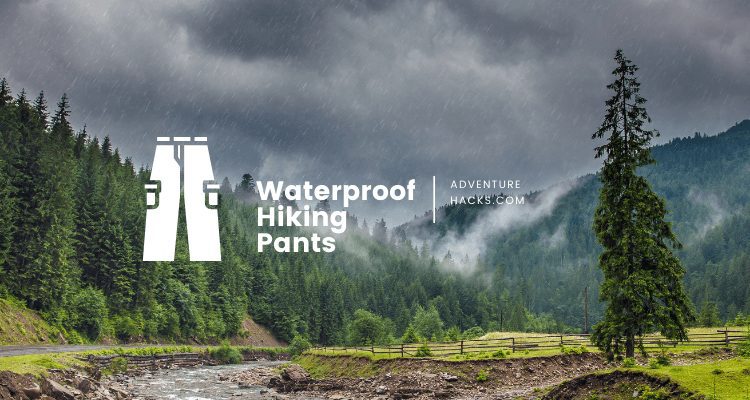
Many purpose-made hiking pants will have waterproof and quick-drying qualities, so waterproof pants aren’t as critical. They’re handy to have in your backpack on longer hikes, in case of sudden downpours.
But if you run hot like I do, gaiters are another option.
Gaiters wrap around your lower legs and keep your socks dry when hiking across streams or through high vegetation and wetlands.
Bang for the buck, I’ve got to recommend my Approach Hiking Pants.
They’re lightweight, moisture wicking, and flexible enough to do anything I need to on the trail.
The best part, they’re affordable and can take quite a beating.
Waterproof Hiking Shoes & Proper Socks
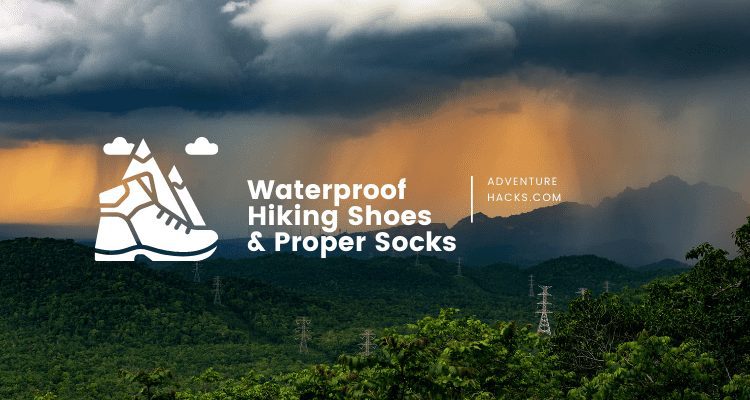
Waterproof shoes and boots are warmer and can be much more comfortable for wet day hikes, especially during cooler seasons. That said, waterproof shoes don’t breathe well and tend to dry slowly if they get wet on the inside.
If you choose waterproof footwear for a multi-day backpacking trip, consider bringing lightweight camp shoes to put on for stream crossings. If you choose non-waterproof footwear for rainy trips, wear wool socks to keep your feet warm.
Remember to keep moving when you’re cold, and always bring thick socks to warm up after the hike.
Hiking socks go hand in hand with your shoes. High-quality hiking socks make a world of difference in how well your feet hold up in wet conditions. Synthetic or wool socks help keep your feet as dry and comfortable as possible.
I usually bring two pairs of thin or medium-weight socks to cycle between while hiking and a pair of warmer socks reserved for camp during backpacking trips. If you prefer non-waterproof shoes, waterproof socks are an option to help keep you warmer and drier.
We only recommend waterproof socks for very short outings though, since your feet may (very good chance since they don’t breath) overheat in them and they aren’t easy to reuse for multiple days without washing.
These Organic Wool Mountain Hiker Socks are our favorite.
Pack These Items On Your Hike In The Rain

If the sky looks ominous during a hike, keep your rain jacket, rain pants, and shelter nearby for quick access without exposing your dry stuff.
When I’m backpacking, and there’s a good chance of rain, I keep my rain gear and tent at the top of my backpack so I can easily grab it when needed. If my tent is wet in the morning, I shake it out and store it inside my backpack, but outside of the waterproof pack liner that contains my other dry gear.
If your tent is lightweight enough, you may also be able to store it on the outside of your pack in a large mesh pocket or securely under a strap.
Otherwise, if I’m doing a day hike, all the gear I need is usually already being worn.
We’re constantly testing items and updating our Essential Ultralight Backpacking Gear List.
Which Backpack to Bring & How To Prep It For Rain
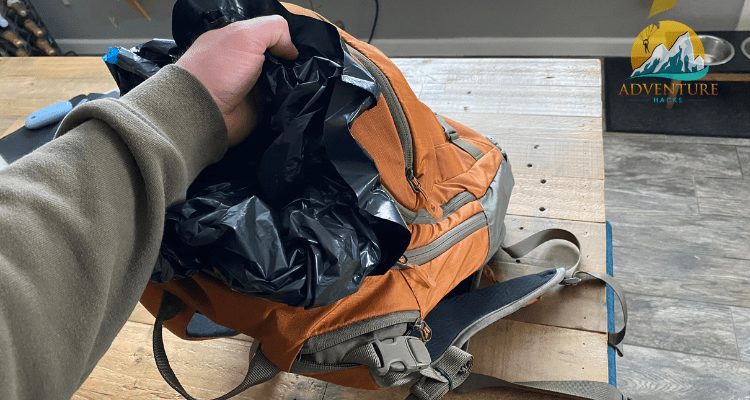
Waterproofing the inside of my Dakine pack since the Wife has claimed my Osprey.
Most backpacks aren’t waterproof, so your stuff will need to be protected from the elements. There are other pack covers that go over the outside of a backpack and pack liners that go inside and function as a large dry bag.
We find many pack covers tend to leave much of your backpack exposed and are ineffective at keeping gear dry when used alone. The most inexpensive and effective solution is to use a trash bag as your pack liner.
We love the Ultralight Osprey Skarab for day trips in wet conditions because the fabric and taped seams make it one of the most weather-resistant packs we’ve tested. If you pair the Skarab with some of Ospreys waterproof stuff sacks/pods, you’ll have a nearly waterproof system that’s lightweight and organized.
You can always also use a rainfly cover (many modern packs come with these, or you can buy a separate one). Rainfly covers are awesome because you can remove the cover and still have a dry backpack.
I personally like to do a combo for my backpacking rain gear. If I know it’s going to rain I’ll put my sleeping bag inside a trash-bag, and my clothes inside another trash-bag.
Then I’ll cover my backpack with a rain-cover. Be sure to pack electronics or any important papers and maps inside separate ziplock bags.
How Much Water To Bring During A Rainy Hike
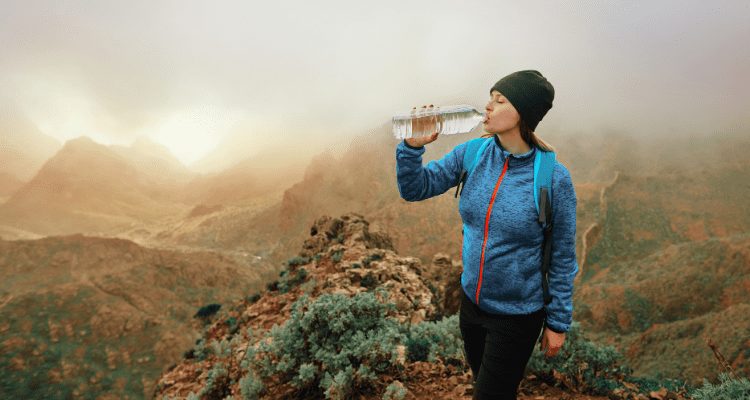
Many people tend to not drink as much water while hiking in the rain. But even on wet, rainy days our bodies need plenty of water (for me it’s at least 2 liters for most hikes) to continue to function properly.
Regardless of hiking, a good rule of thumb is to drink enough water to urinate clear.
Cognitive and physical decline begin to show when we are as little as 2% dehydrated. So if you’re hiking, rainy or not, it’s a good idea to drink water throughout.
In fact, here are 5 Signs You’re Not Sick, You’re Just Thirsty.
Since we sweat when we hike and we are diluting our electrolyte and mineral concentrations with water, be sure to eat something salty during your adventure.
This brings me to my next tip, what to snack on during a hike.
Pack Easy Snacks
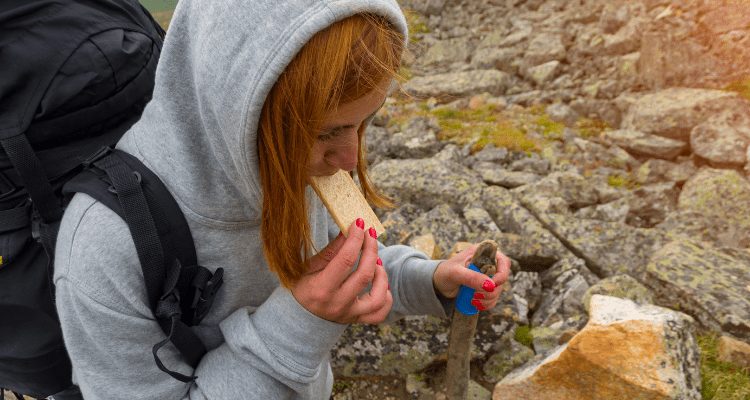
Snack small and often throughout the day, instead of big snacks infrequently.
Doesn’t matter where I’m hiking or for how long, I always carry a bag of mixed nuts and / or trail mix with me.
Tree nuts are loaded with nutrients, good fats and calories to energize us through just about any situation.
My hiking snacks rarely change, they typically consist of:
- Jerky
- Mixed Nuts
- Sandwiches
- Canned Food (Tuna)
- Crackers
- Dried Fruit
These are all very easy to carry and quick to eat which make them perfect for hiking, especially in the rain.
Cooking In The Rain
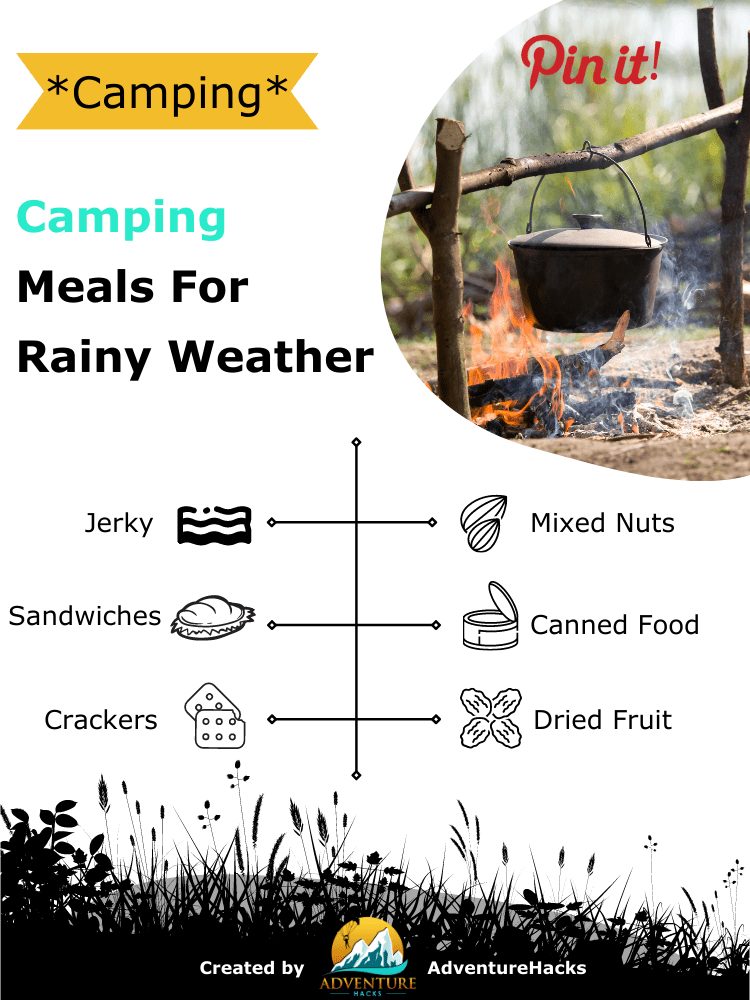
Often times on longer hikes, I’ll whip out my jet boil and make some tea, coffee, or a freeze dried meal. Let me tell ya, there are few things more frustrating than cooking in the rain.
As mentioned above, regardless of rain or not, my hiking meals tend to consist of 6 types of food:
- Jerky
- Mixed Nuts
- Sandwiches
- Canned Food (Tuna)
- Crackers
- Dried Fruit
If you’re on a long hike, or camping, and the rain is terrible, consider cooking in the vestibule of your tent. This is assuming you aren’t in bear country.
Typically my advice is to avoid cooking or eating in your tent area 100% of the time, but we can make some exceptions if you’re aware of your surroundings. Just be sure to open the flaps so carbon monoxide can escape.
Cooking in your tent is extremely dangerous and leaves you susceptible to carbon monoxide poisoning.
Only cook in well-vented areas, such as a vestibule with the flap wide open, under the shelter of a tree, or in the open.
Alternatively, you can use a pack cover and a few hiking poles to rig a small sheltered area to cook in. Be sure to angle the hiking poles outward, not straight up and down, for more stability.
Or, go completely stove-less with the hiking foods I listed above.
Setting Up Camp In The Rain

If you’re on a longer hike aka backpacking, you may need to setup a tent without getting it soaked. First things first, try and set up camp in an ideal location.
Here are a few quick camping in the rain tips:
- Camp at least 200 feet (70 adult steps) from water sources (river, lakes, streams, ponds). This isn’t just for “Leave No Trace,” but for flooding and predators.
- Avoid low/lying areas, especially in the desert. Sandy washes might be inviting, but these drainages turn into rivers quickly, even with light rain.
- Keep the tent vents open (unless there’s a gnarly wind blowing rain into the tent). This helps with condensation build up, which leave you a damp, nasty tent.
- If you’re above the tree-line, find a lower, sheltered area. Stay off summits, ridge-lines, and small clusters of trees which make you a target for lightning strikes.
- Keep low, but not too low. You don’t want to be in a ditch, and don’t want to be up high either. If you’re in a forest, look for mid-sized, healthy trees to camp under. Never camp under taller, dead trees or solo trees.
If you need reliable camping gear, check out our adventure shop, my team and I are testing and adding gear regularly.
Also, if you want to see specific gear, content or anything else featured, please let us know via our Requests Page.
Choose to Have a Positive Attitude About Hiking in the Rain

Having a positive outlook and a sense of humor makes hiking in rainy conditions much more enjoyable.
You might be a bit uncomfortable at times, but stormy trips tend to be some of the most memorable. An extra dose of enthusiasm will go a long way to lifting your spirits and those of your hiking partners.
If you’re struggling to stay warm, keep in mind that you can always adjust your clothing, pick up your hiking pace, take a break to make a hot beverage, have an impromptu TRX session, or even set up camp early if you need to.
One of the most important skills of hiking is learning how to take care of yourself if you have to hike in sustained rain and stay happy.
How to Hike in the Rain – and Love It!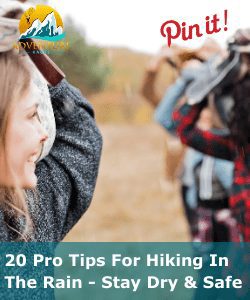
Your attitude plays a big part in how good an experience hiking in the rain will be. If you go out with the mindset that it will be miserable, then it will be miserable.
The opposite is also true 99% of the time.
There’s no doubt rainy and cold conditions add an element of challenge to getting outside.
But, don’t let a wet forecast stop you from being active and immersing yourself in nature.
The right mindset and quality rain gear make all the difference.
To your next Adventure,
-David Aston



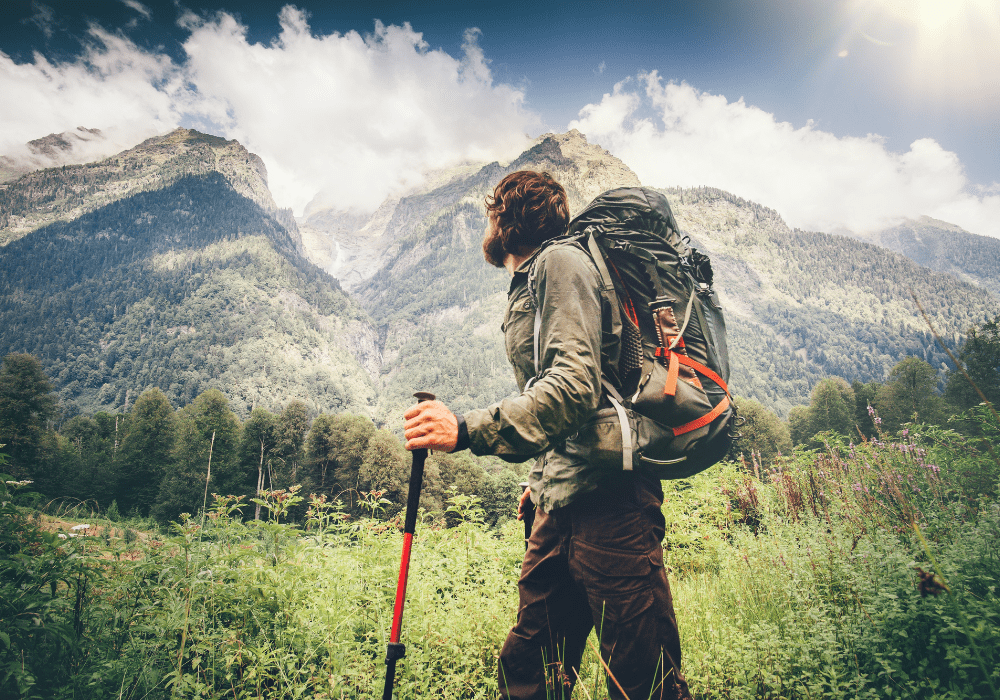
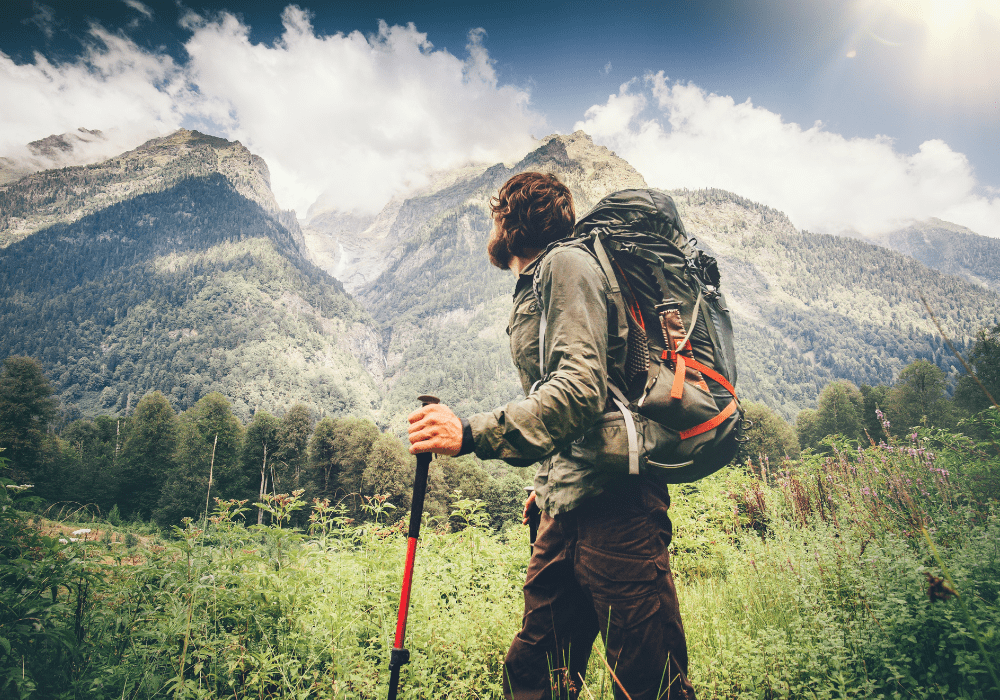
Pingback: What Gear To Bring on A Day Hike - AdventureHacks
Pingback: 5 Reasons Gold Nugget Panning Is A Great Family Adventure - AdventureHacks
Pingback: How to Prepare For the Unexpected While Hiking
Pingback: 7 Health Benefits of Backpacking
Pingback: 14 Pros & Cons of Hiking with Trekking Poles - AdventureHacks